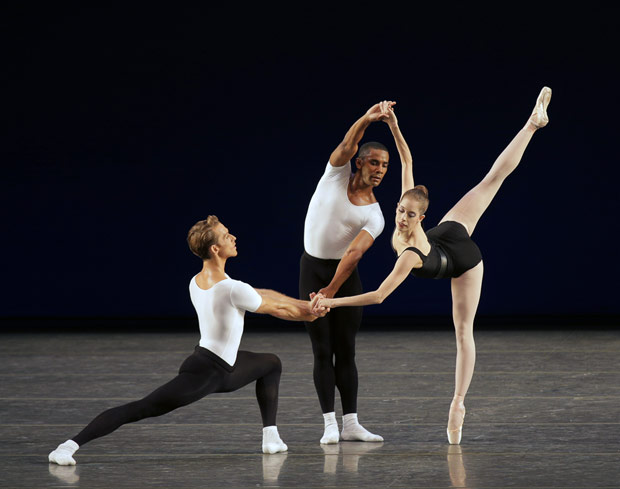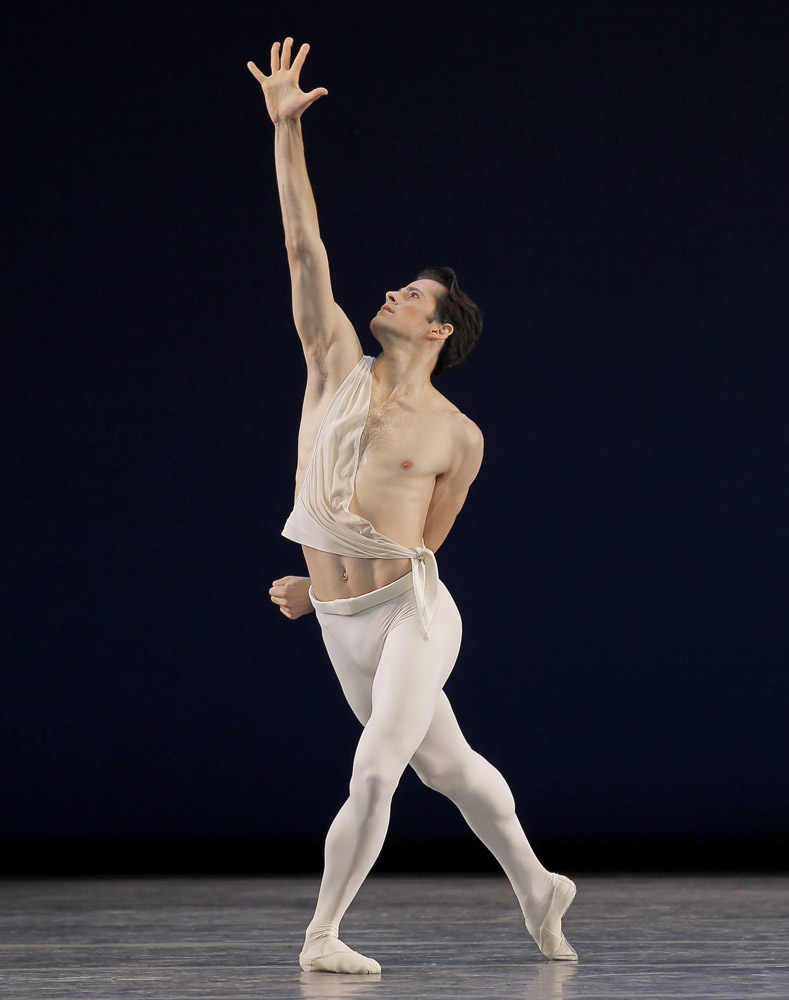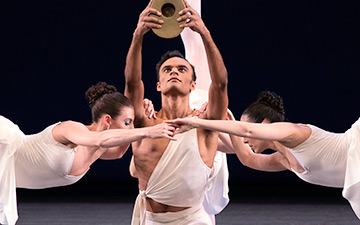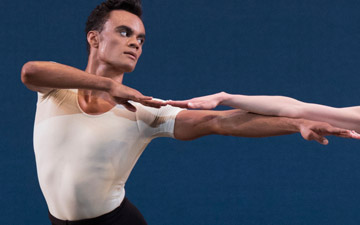
© Paul Kolnik. (Click image for larger version)
New York City Ballet
Greek Trilogy: Apollo, Orpheus, Agon
New York, David H. Koch
18, 19 September 2012
www.nycballet.com
Signs of Life: Balanchine/Stravinsky “Greek Trilogy” at New York City Ballet
New York City Ballet’s fall season is still a relatively new concept, dating back only two years. It originated as a bit of a land-grab, a sign of the power-shift at the Koch Theatre when its sister institution, the New York City Opera, began its quick and dispiriting retreat from Lincoln Center. Perhaps for that reason, until now, the fall season has felt slightly aimless, like a warm-up for the winter rep, or an addendum to the summer season. But this year it seems to have found its sense of purpose: the company has opened with a mini-festival exploring the remarkable affinities between Balanchine and Stravinsky, after which it will present something new, a ballet by a young dancer in the corps, Justin Peck.
The Stravinsky/Balanchine works have been divvied up into three programs, with twelve ballets in all. (By the way, these twelve do not represent the totality of Balanchine’s Stravinsky ballets. Neither Élégie nor Card Game, for example, is included. Except for Orpheus and Scherzo à la Russe, all of the dances being performed this fall are part of the regular rep. There are no surprises or major revivals.) On September 18 the season opened with a triple bill dubbed, for obvious reasons, the “Greek Trilogy”: Apollo, Orpheus, and Agon. (The program was repeated, with different casts, on Sept. 19.) In the case of the first two, the Greek sources are clear. Agon, a more abstract work, is Greek only in that agon is a Greek word meaning “contest”. (Which is not to say that the ballet represents a contest, really, though the suite can be read as a series of games.)
In any case this threesome lies very close to the heart of the company’s identity; it is like a strand of its DNA. Apollo, made in 1928 for Diaghilev’s Ballets Russes, is Balanchine’s earliest extant ballet. Though he had created dozens of works before then, in St. Petersburg and, at Diaghilev’s bidding, for the Monte Carlo Opera, the choreography for these has disappeared. In a way Apollo was a new beginning; as Balanchine wrote in 1947, “It was in studying Apollo that I came first to understand how gestures, like tones in music and shades in painting, have certain family relations.”* This is perhaps the most important lesson he ever learned. Balanchine brought the ballet back again and again, making various adjustments (both to the décor and to the steps) and cuts over time. In other words, it was a ballet he cared about, and wanted to keep current and alive.
Orpheus is certainly the strangest of the three, an enigmatic, uneven work that is nonetheless central to the company’s identity. Simply put, there might never have been a New York City ballet were it not for Orpheus. Made in 1948 for NYCB’s predecessor organization, Ballet Society, it so captured the imagination of Morton Baum, director of New York City Center, that he decided to invite the struggling organization to become one of his in-house companies (along with City Opera). Baum’s backing led directly to the establishment of New York City Ballet as a viable company.
And then there is Agon, from 1957, an absolute marvel of wit, sophistication, and musical intelligence. Both the score and the dance are pure sinew and bone, without an ounce of fat. In a good performance – and the company is dancing it particularly well these days – it still makes you laugh at its sheer cleverness, the elegance of its imagery, and its capacity to surprise. Audiences are still electrified by it, just as they were at its première. Of the three ballets on the opening bill, it is by far the most completely alive at this point in the company’s history. New York City Ballet owns the ballet; it’s hard to imagine another company dancing it better, with more sense of style or understanding. This was true both of the more experienced cast on Sept. 18, and of the younger one that followed on Sept. 19. The knowing way Teresa Reichlen (Sept. 19) swings her arms, à l’espagnole, in the “Bransle Gay,” as two men “clap” the rhythm behind her (echoing the castanet in Stravinsky’s score) sends shivers of delight down one’s spine. As do the two women in the “Gailliard,” dancing side by side in perfect synchronicity, their dainty steps transporting us to a court dance in a Baroque palace, clapping their hands for punctuation, heads tilted back regally. The joke is in the way Balanchine combines their clean, airy steps with deep, juicy pliés with the feet in a wide stance – ha ha, not so elegant now! – only to gather them up into more absolutely precise, forward-traveling steps on pointe. No fireworks, just space and air and locomotion, and a little inside joke. (Both pairs of women, Ashley Laracey and Megan LeCrone the first night, and Amanda Hankes and Gretchen Smith the next, were very good.)
The famous pas de deux in Agon is a kind of erotic combat that begins with infinite politesse, in a formal pose worthy of Sleeping Beauty, and ends with the man’s surrender, on his knees. It was danced, on both nights, by Maria Kowroski, with two different partners. (On Sept. 18 her adversary was Sébastien Marcovici, a worthy if slightly subservient opponent, while on Sept. 19 it was the more cheeky, gleeful Amar Ramasar. On the latter evening, Kowroski was stepping in for an injured Wendy Whelan.) She is an introspective, somewhat remote dancer, but here – as in Apollo – she looked more engaged than she has in a good long while. Especially with Amar Ramasar – a fine dancer with long lines, clean feet, and nice timing, if only he could tamp down his impulse to mug – she really let go. She seemed almost unhinged, flinging herself into the contorted poses – for which her body is particularly suited – with an audaciousness that was slightly surprising. The title of the ballet suddenly made sense: it is a contest of wills, fought by two masters of combat.

© Paul Kolnik. (Click image for larger version)
The company has a slightly harder time with Apollo, though the second night’s performance was vastly more assured than the first. It is one of those ballets that, though performed often enough, is in danger of slipping into the ether of myth. And not just at NYCB; last season ABT’s dancers struggled with it as well. Many dancers seem to approach it with a kind of reverence or desire to explain each movement that kills its freshness and mutes its delicate poetry. By cutting the prologue (in the seventies), Balanchine removed the framework that explained the ballet’s “story” – that of a newly-born God finding his way in the world. Now, as the curtain opens, Apollo appears in perfect stillness, with one arm handsomely poised overhead, a picture of male grace. It’s a hard pose to pull off, and one of those moments in ballet where physique plays an inescapable role. The appearance of Chase Finlay – tall, broad-shouldered, long-legged, his musculature tense and soft at the same time, chin slightly lifted – is immediately convincing. Robert Fairchild, just as handsome, but in a warmer, friendlier way, makes less of an impression. Therefore one can feel him working harder from the very beginning to show us what he has done with the role, which is quite a lot really. He seems to have thought about it at great length, and imbues each movement with meaning, texture, as well as subtle and not-so-subtle variations in weight. “Now, I’m testing my legs,” he shows us, “and now, look how my lute-playing has gained in subtlety.” But, in part because of this minute attention to detail – and a healthy desire to test the limits of his abilities – the arc is choppy and the shapes don’t radiate as well as they should. We see a process, not yet an end. (Which of course means that there is still space for the interpretation to settle.) Chase Finlay’s Apollo is more fully formed, which makes sense, since it seems as if he had been born to dance this role. Though he tires toward the end (understandably), he looks more in his element: a natural self-assurance (cockiness?) combines with youthful vulnerability that tends to shine through in moments when the energy flags – a heady mix. His strong, pliant jump and pillowy plié add another level of amplitude to the role. It’s danced more through the body, and less with the mind, or at least that is the impression.
The Sept. 18 Apollo made me worry that the ballet might be slipping through the company’s fingers. The muses – Ana Sophia Scheller, Tiler Peck, and Sterling Hyltin – were not well matched in temperament or style, and seemed to be dancing in three slightly different versions of the ballet. Scheller, a powerhouse-type dancer who was recently elevated to principal, looked forced in the delicate, witty role of Calliope, muse of poetry. Peck, who usually dances with such expansive ease, seemed to be reining herself in in every way, including the adoption of a Very Serious Expression. Our Terpsichore, Hyltin, wore a worried expression and danced with a slightly nervous brittleness. Stranger yet, the usual chemistry between Hyltin and Fairchild was nowhere to be found: the pas de deux never blossomed. All the steps were right, but the ballet never quite came alive. Perhaps it was just a case of opening-night jitters.

© Paul Kolnik. (Click image for larger version)
Matters were set right, however, on the following night (Sept. 19), with Teresa Reichlen, Maria Kowroski, and Rebecca Krohn in the roles of the muses to Finlay’s Apollo. Despite it being her début in the role of Polyhymnia, Reichlen was quite at home as the slightly silly, flirtatious muse of mime who cannot keep her mouth shut. (Is Reichlen ever not completely at ease? If so, I have yet to see it.) More importantly, despite the gap in experience and the fact that she is possibly a bit too tall for him, the rapport between Kowroski and Finlay clicked quite nicely. And oh those beautiful lines! As Finlay lowered her into splits and lifted her up again, she betrayed not the slightest effort, enveloped in a quiet aura of loveliness. In the playful chase that followed, the two gave the impression of enjoying the game, momentarily reverting to their younger selves.
What is there to say about Orpheus, except that it seems to slip deeper into the recesses of time? I’ve read that at the première, the critic and poet Edwin Denby was so moved by it that he sat dumbfounded during intermission, unable to stand. It is difficult to imagine such a reaction today, despite several moving passages. One can’t help thinking that it looks like watered-down Martha Graham, partly because of the cartoonish, bulbous costumes and sets by Noguchi. What is it about the thick piping on the men’s costumes and the crocheted doilies covering the women’s breasts and groin, that makes them look so impossibly not-of-our-time? I will not linger on the tubular appendages on the unflattering unitards the “nature spirits” and furies. But it’s not completely Noguchi’s fault. The main weakness of the ballet is its lack of tension, musical or choreographic. The utter banality of the Hell scene, which after all is the heart of the story, is befuddling; neither the music nor the choreography give any sense of the grandeur and terror of death. (For a bit of context, just listen to the “Furientanz” from Glück’s Orpheus.) There’s no other way to put it: Stravinsky’s sound world – plucked strings, quiet horns, glissandos, woodwinds – is trivializing, as if the subject embarrassed him. In response, Balanchine’s choreography for the Furies – a battalion of child-like creatures who high-kick and hop, two-footed, while flapping their elbows like chickens – is almost comical. (Interestingly, the same is true for the monsters in his Firebird.)
To make matters worse, the Bacchantes who tear Orpheus limb from limb are even more ridiculous, with their comical blonde tresses and fierce demeanors. It’s The Cage, light. Even so, the ballet has its moments. I happen to find the opening, with Orpheus’s repeated keening circle around the grave, to be quite moving, as well as the end, in which Apollo – Orpheus’s father – mourns for his son and “plays” the mask that represents his spirit, calling forth a final song, a haunting melody on the horns. Balanchine has also given his Orpheus two intriguing pas de deux, one with an ambiguous and creepy “dark angel” (male) – who leads the wilting hero to the underworld – and another with the desperate, erotically-rapacious Eurydice. She exerts every feminine wile she knows, wrapping herself around his body like a snake, in order to get him to look at her, with terrible consequences. Both duets are clingy and viscous, reliant on a kind of insistent push-and-pull that is quite atypical for Balanchine. (Though not completely unique; the acrobaticism is reminiscent of Bugaku, for example.) But none of this is enough to save the ballet, at least in its current state, more a curious artifact than a living, breathing work with relevance in our time. Both of the dancers who performed Orpheus, Sébastien Marcovici (9/19) and Ask la Cour (9/18) looked slightly lost, and one can’t really blame them – there is not much for this Orpheus to do. On the other hand, both Janie Taylor (9/19) and Wendy Whelan (9/18) seemed to relish the role of Eurydice. Taylor, especially, danced with an almost feverish sense of urgency, eyes burning, body twining around and around her partner’s like a toxic vine.
Ballets live and ballets die; this one seems to be in the latter stages of Limbo. But there are many signs of life at New York City Ballet.
* This oft-quoted line appears in Nancy Goldner’s Balanchine Variations, p. 6.

















You must be logged in to post a comment.